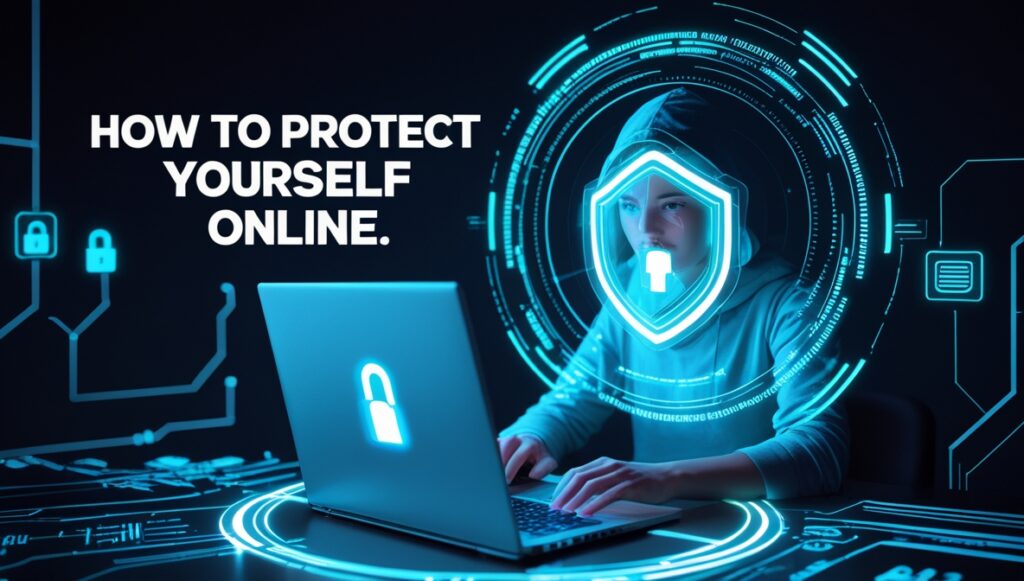Learn How to Protect Yourself Online in 2026 , the Simple Cybersecurity Tips you need to know.
In today’s digital-first world, being online is unavoidable. From shopping and banking to working remotely, we share more personal data than ever. But with convenience comes risk: cybercriminals are evolving just as fast as technology.
By 2026, online scams, phishing attacks, and data breaches are more sophisticated making cybersecurity skills a must-have for everyone, not just IT experts.
This guide will show you how to protect yourself online in 2026 using simple, practical steps.
Step 1: Strengthen Your Passwords
Weak passwords are still the #1 cause of hacked accounts. In 2026, cybercriminals use AI to guess millions of combinations in seconds.
Tips for Secure Passwords:
- Use at least 12–16 characters.
- Mix letters, numbers, and symbols.
- Avoid personal info (birthdays, names, pets).
- Use a password manager like 1Password, Bitwarden, or LastPass.
Bonus: Enable passkeys (passwordless login) where available it’s safer and faster.
Step 2: Turn On Two-Factor Authentication (2FA)
Even the strongest password can be stolen. That’s why 2FA is essential.
Types of 2FA in 2026:
- Authenticator Apps (Google Authenticator, Authy).
- Biometrics (fingerprint, face ID).
- Hardware Keys (YubiKey, SoloKey).
Always prefer app-based or hardware-based 2FA over SMS, which is easier to hack.
Step 3: Stay Alert Against Phishing
Phishing attacks are now powered by AI-generated emails and websites that look almost identical to real ones.
How to Spot Phishing in 2026:
- Check the email domain carefully.
- Look for spelling/grammar mistakes.
- Don’t click unknown links or download attachments.
- Verify requests for payments or personal data by contacting the company directly.
Use a browser with built-in anti-phishing AI like Brave or Chrome 2026 edition.
Step 4: Secure Your Devices
Hackers often get in through outdated software.
Device Security Checklist:
- Keep OS and apps updated.
- Use a reliable antivirus (Norton, Bitdefender, Kaspersky).
- Enable a firewall.
- Encrypt your hard drive (BitLocker or FileVault).
If you’re working remotely, consider a VPN to protect your browsing.
Step 5: Protect Your Social Media
Social media is a goldmine for identity thieves.
Safe Social Media Practices:
- Limit personal details (avoid posting your home address, daily schedule).
- Set profiles to private when possible.
- Watch out for fake friend requests.
- Don’t overshare travel plans, criminals use this info.
Step 6: Backup Your Data
Cyberattacks like ransomware are more common in 2026. If hackers lock your files, backups can save you.
- Use cloud backups (Google Drive, OneDrive, Dropbox).
- Keep an offline backup on an external hard drive.
- Schedule automatic backups weekly.
Step 7: Shop and Bank Safely Online
E-commerce and digital wallets are booming in 2026.
- Only shop on HTTPS-secured sites.
- Use virtual cards for online purchases.
- Turn on transaction alerts from your bank.
- Never save payment details on public/shared devices.
Step 8: Watch Out for AI Scams
By 2026, scammers use deepfakes and AI voice cloning to impersonate loved ones or bosses.
- Verify suspicious calls or messages through a secondary channel.
- Don’t rush into urgent requests (scammers create panic).
- Be cautious of unexpected payment instructions.
Step 9: Teach Your Family Cybersecurity Basics
Cybersecurity isn’t just personal it’s for your whole family.
- Teach kids not to click suspicious links.
- Help elderly family members set up strong passwords and 2FA.
- Use parental control software to protect children online.
Common Mistakes to Avoid
- Using the same password across accounts.
- Ignoring software updates.
- Trusting “too good to be true” offers.
- Clicking unknown links out of curiosity.
Staying safe online in 2026 isn’t about being tech-savvy it’s about being cautious and consistent.
By following these simple steps, you can:
- Protect your accounts and devices.
- Avoid scams and phishing attacks.
- Keep your personal and financial data secure.
The internet is powerful but only if you use it wisely. Start applying these cybersecurity tips today, and you’ll enjoy a safer digital life.
FAQ
What’s the #1 way hackers steal data in 2026?
The most common methods are phishing emails and weak passwords. Using 2FA and strong passwords can prevent most attacks.
Is antivirus still necessary in 2026?
Yes :- even though operating systems have built-in protection, antivirus software adds extra layers against malware, ransomware, and phishing.
Should I use free VPNs for online safety?
Avoid free VPNs. Many of them sell your data. Use trusted paid VPNs like NordVPN, ExpressVPN, or ProtonVPN.
How do I know if a site is safe for shopping?
Look for HTTPS, check reviews, and avoid sites that look poorly designed or ask for unusual personal information.
Are AI scams really dangerous?
Yes :- deepfakes and voice clones are so realistic in 2026 that people can be tricked into sending money or data. Always double-check identities.





